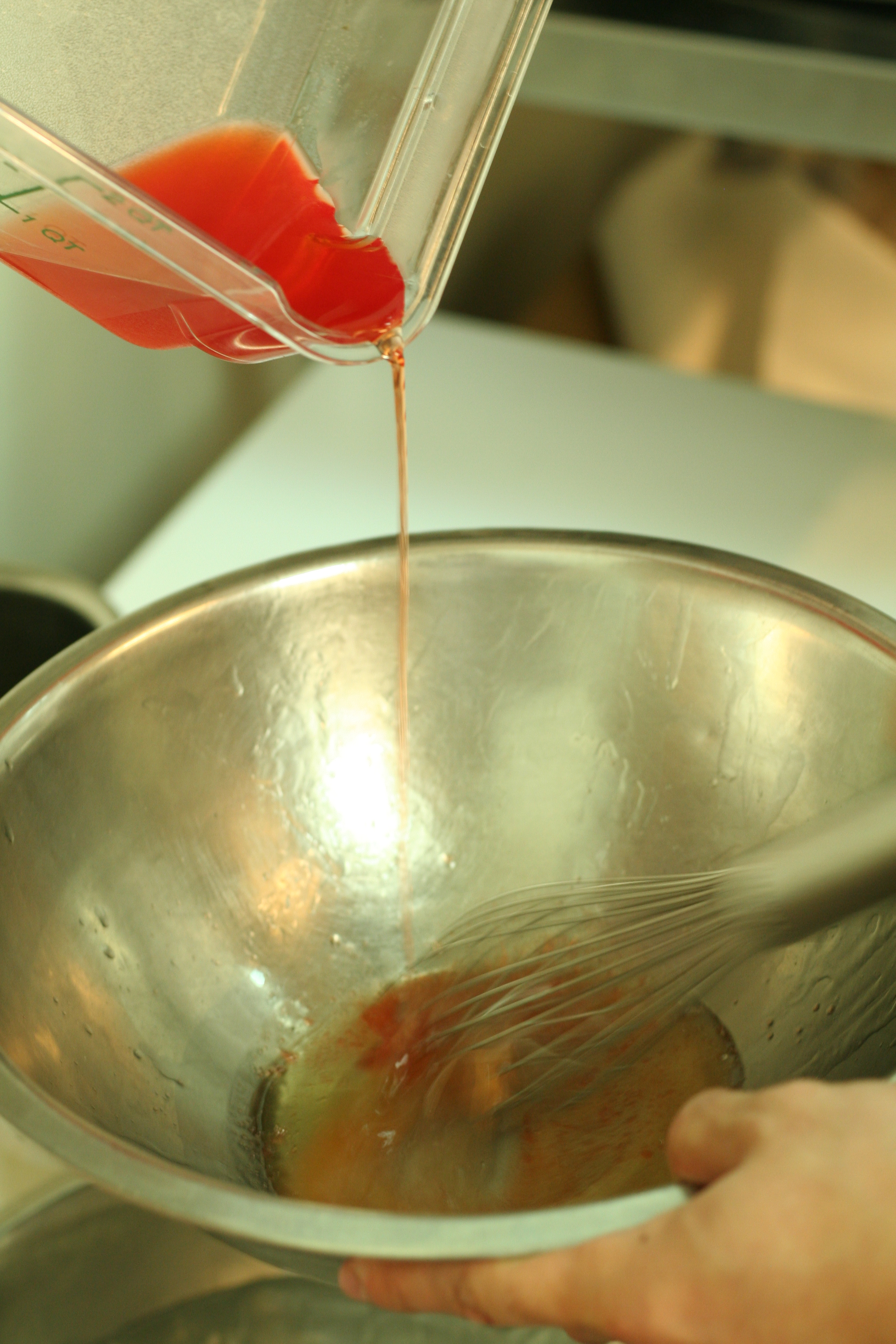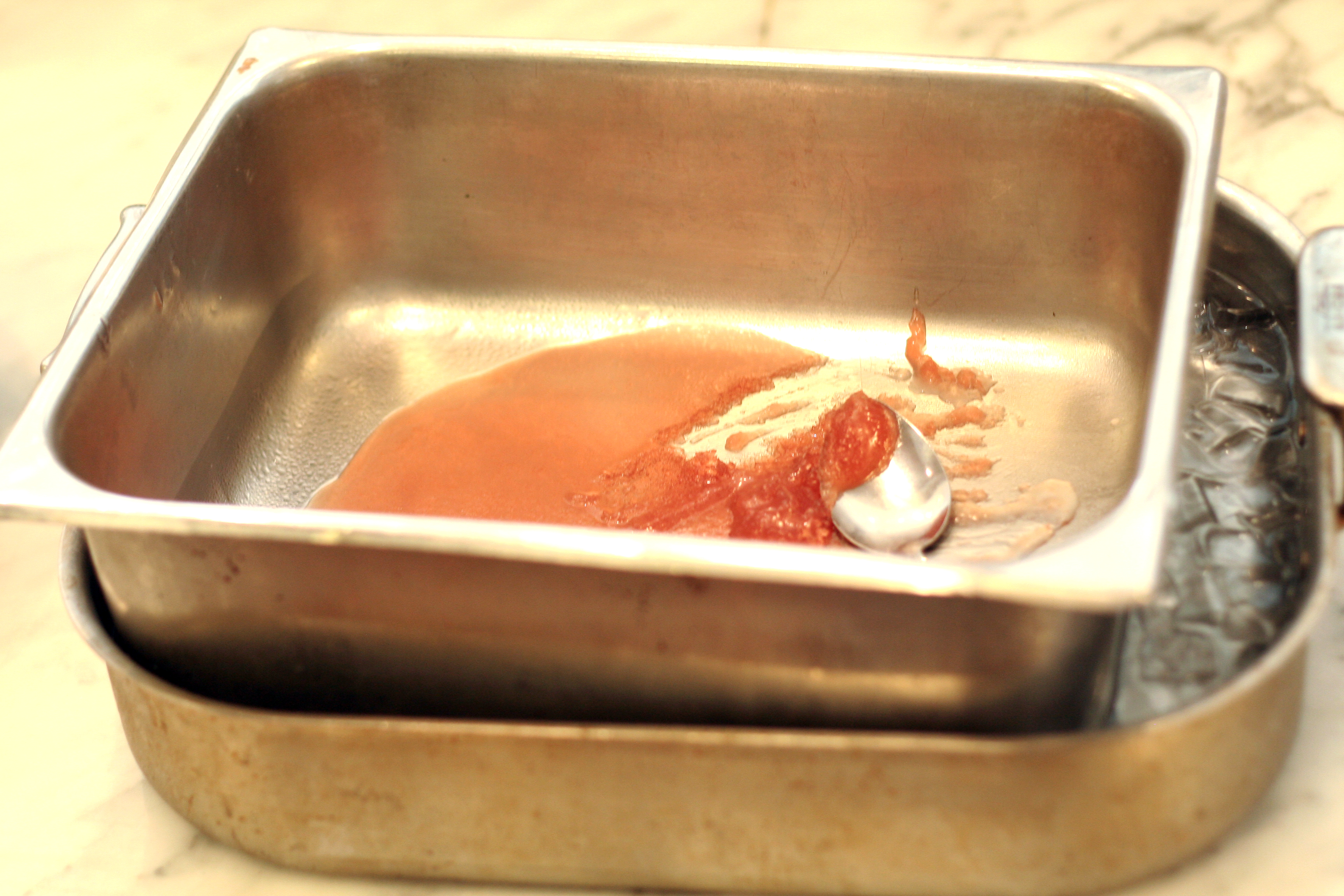Posted by Mindy Lvoff
Purpose: Make tobiko-sized hydrocolloid beads
Technologies Used: Hydrocolloids, Emulsifiers

During our two-day Hydrocolloids class at the French Culinary Institute, students inevitably want to know how to make “caviar” beads. Whether using agar or alginates, and no matter how steady your hand, you inevitably end up with Ikura or salmon roe-sized spheres. Actually, if you’re just starting out, you end up making salmon roe-sized tadpoles—spheres with little tails. After students take turns trying to out-sphere each other, the same question always comes up: How do you make smaller, flying fish roe or tobiko-sized caviar? Until now, Dave had a theory on how to do it, but never a definitive answer. This time, the night before class started, it was time to put his theory to the test.
Glycerin flakes don’t contain glycerin. They are actually monoglycerides and diglycerides used to emulsify fat and water. Texturas markets them as “Glice” flakes and, unfortunately, Terra Spice calls them “Glycerin Flakes” to keep the naming convention. One more time: glycerin flakes are monoglycerides and diglycerides. When dissolved in oil (fat) heated above 60°C and mixed into vinegar, the glycerin flakes emulsify and stabilize a mixture. Dave wondered what would happen if you mixed the ingredients in the reverse, i.e., whisk the vinegar into the oil. A light bulb went off (probably a giant halogen bulb, tantamount to the high-beams on an SUV in the middle of the night) and he began to think about cold oil spherification (caviar balls)… With mayonnaise, oil is dispersed in/whisked into water and then suspended, making water the “continuous phase,” which basically means that micro beads of oil are suspended in water. Dave theorized that you could make oil the continuous phase by whisking a mixture of agar and vinegar into the monoglyceride and diglyceride-spiked oil, thereby suspending tiny beads of the agar vinegar. Perhaps you could find a way to recover those beads from the emulsion, meaning you would end up with tobiko-sized caviar!

whisking agar+vinegar mixture into mono+diglyceride oil
Dave set to work and dissolved glycerin flakes into lemon oil heated above 60°C. Agar was dispersed cold into red wine vinegar sweetened with simple syrup, then boiled to hydrate. The mixture was chilled over an ice bath where the oil began to separate and rise to the top. Dave scraped a spoon through the cold, cloudy oil, down to the grainy red agar-vinegar that had settled to the bottom. He rinsed the mixture with hot water to wash away the lemon oil and then dried it by gently rolling it in a paper towel. It looked exactly like and had the mini crunch of tobiko, but was sweet and tangy like vinaigrette.
Since then, we’ve made several successful and unsuccessful attempts, and through trial and error, we’ve figured out a few important factors to reproducing tobiko. It’s important to use hot tap water to rinse the tobiko—rinsing it for too long washes out some of the flavor, so hot water works best to quickly wash off the oil. The lemon oil also imparted a noticeably better flavor to the tobiko than when we substituted grapeseed oil. We also found that reducing the vinegar-syrup mixture to concentrate the flavor helped combat both the flavor and color washout during the rinse phase, but that the agar didn’t hydrate well this way. To correct for this, Dave dispersed and hydrated the agar in a small amount of water and then added the heated, reduced vinegar mixture. This seems to work best so far.
At first, Dave and I were the only ones able make tobiko even though we communicated how to do it to several different, skilled people. Dave knew what approach he wanted to take and managed to create the tobiko out of sheer luck. When it was my turn, I followed his instructions verbatim—down to the order in which I mised out products and the exact size of the bowl he had used. Of course, this recipe would not be so useful if only Dave and I understood what it meant. Luckily, Dave played with the process and wrote a working recipe so that now you, too, can create your own tobiko caviar. Please let us know when you do!
Agar Tobiko
1 g Mono & Diglycerides, aka Glycerin flakes (2% of oil)
50 g Lemon oil
100 g Concentrated vinegar mixture (any vinegar + simple syrup, reduced until flavor is concentrated)
1.5 g Agar agar (1.5% of sweetened vinegar + water mixture)
50 g Water (cold)
1. Add glycerin flakes to lemon oil and heat in a medium-size bowlto above 60°C to dissolve, stirring occasionally. Set aside.
2. Bring sweetened vinegar to a boil simultaneously with Step #3.
3. Stir agar into cold water to disperse. Bring mixture to a boil while stirring and continue boiling until agar is dissolved.
4. Stir boiling, sweetened vinegar mixture into boiling agar + water mixture. Bring combined mixture back to a boil.
5. Whisk mono & diglyceride oil mixture rapidly while drizzling in vinegar mixture to emulsify.
6. Allow mixture to cool in bowl under observation, occasionally tilting bowl side-to-side to check size of agar beads. If beads are too big and are clumping together, make sure to whisk. However, over-whisking will create beads that are too fine.
7. When agar beads reach the desired tobiko size, quickly poor out mixture into a hotel pan over ice in a thin layer to set agar as quickly as possible.
8. When agar beads are set, place tobiko mixture in a fine chinois and rinse quickly under hot water. Gently drain and dry with paper towels.

immediately chill agar tobiko in hotel pan over ice in a thin layer when desired bead-size is achieved

I like it! Do you think another emulsifier, like lecithin, would work too?
(ps – really enjoyed the ECC talk today!)
Nils says thanks for the kind words about his talk.
Dave says:
I’m not sure. You’d need to use one with the correct hydrophilic/lipophilic balance. For this application you need something relatively lipophilic that wants to make water-in-oil emulsions. I believe my mono and diglycerides are more lipophilic than my lecithin, but sinch both products are manufactured in a wide range i’m not sure! Check this link: http://en.wikipedia.org/wiki/Hydrophilic-lipophilic_balance
have you ever thought of spraing an agar solution through a squirt bottle onto cold oil? the spraying would create tiny droplets and as they heat the cold oil they would set. of course you would have to keep the contents of the bottle hot enough to keep the agar from gelating.
If you try it let us know how it works! By a squirt bottle do you mean something similar to a sprayer with a nozzle? I wonder if you could get a really uniform size? Thanks for reading.
Nice! I’ll include this in the next update of “Texture – A hydrocolloid recipe collection”.
Thanks! BTW, when we use agar we always use telephone brand (it is a powdered agar, not flakes), because it it very easy to source here on the east coast of the US. It is in every asian grocery store. We like to use some ingredients that anyone can go buy.
Very interesting. Maybe I’m missing something here, though: why do we need to add glycerine flakes to the oil? Usually the agar in cold oil technique does without.
Hi Cosimo,
The mono and diglycerides are there to helm make small balls that are semi stable. After the ball size is right (after a certain amount of de-mulsification) we set it just like cold oil. When this technique works it is great –but it is really finicky. We now use a technique we learned from the pastry kitchen at Jean Georges, which uses gellan and a blender. The tobiko isn’t quite as good, but it works 100% of the time. I will try to find the recipe –it isn’t in my head.